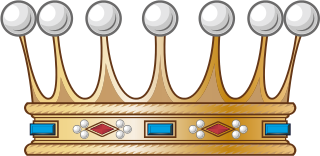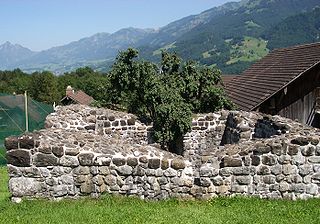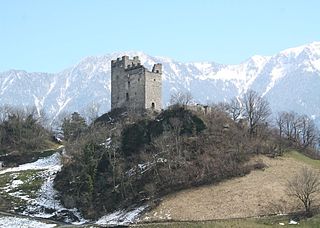History
The Freiherr von Schweinsberg first appears in documents in the 13th century at Wartenstein Castle in the Bernese Emmental. But a branch of the family was in Uri by the mid 13th century and occupied the castle, sometimes adopting the castle's name as their family name. By 1300 there were two branches, one under Werner II who held the lands in Uri and another under Diethelm I in the Berner Oberland. The Uri branch of the family is traditionally believed to have been critical supporters of the Three Forest Cantons and the early Swiss Confederacy. Werner II and his son Johann were the Landammann of Uri from 1294 until 1358/59. [2] It is unknown what role, if any, Werner played at the Battle of Morgarten in 1315, but in 1339 Johann led the army of Uri at the Battle of Laupen.

Freiherr, Freifrau and Freiin are designations used as titles of nobility in the German-speaking areas of the Holy Roman Empire, and in its various successor states, including Austria, Prussia, Bavaria, Liechtenstein, Luxembourg, etc. Traditionally it denotes the titled rank within the nobility above Ritter (knight) and Edler and below Graf and Herzog (duke). The title superseded the earlier medieval form, Edelherr.

Wartenstein Castle is a castle, now in ruins, located in the municipality of Lauperswil in the Canton of Bern of Switzerland.

The canton of Bern or Berne is the second largest of the 26 Swiss cantons by both surface area and population. Located in west-central Switzerland, it borders the canton of Jura and the canton of Solothurn to the north. To the west lie the canton of Neuchâtel, the canton of Fribourg and canton of Vaud. To the south lies the canton of Valais. East of the canton of Bern lie the cantons of Uri, Nidwalden, Obwalden, Lucerne and Aargau.
The Schweinsberg/Attinghausen family owned Attinghausen Castle in the 13th century. As their fortunes grew in Uri, they built a second castle, Schweinsberg, a short distance north of Attinghausen later in the 13th century. The castle was probably built as a residence for knights in the service of the Freiherr of Attinghausen/Schweinsberg. Very little is known of the early history of the castle, though much of it is tied with the fortunes of the Attinghausen/Schweinsberg family.

Attinghausen Castle is a ruined medieval castle in the municipality of Attinghausen in the canton of Uri in Switzerland. It is a Swiss heritage site of national significance.
On 1 May 1351, Rudolf Brun of Zurich and Johans von Attinghausen signed an alliance that brought Zurich into the growing Swiss Confederation. In 1353 they received the a fief that included the Imperial customs post at the Castle of Rudenz and became the Rector over Valais. However, in 1358 Johann died. Traditionally, it was believed that he died during an insurrection, which also destroyed the castle. However, more recent research indicates that he might have died of disease or while marching with his army. [3] [4] Johann's son, Jacob, was with the Pope in Avignon, but did not return to Uri or died while returning. Two of his cousins, Werner and Johann von Simpeln probably took over the Attinghausen lands and Attinghausen Castle in 1359. However, they both died soon thereafter, either of disease or in the 1360 fire that destroyed the castle. The Lords of Rudenz then inherited the Attinghausen lands and Schweinsberg Castle passed through a number of owners.

A fief was the central element of feudalism and consisted of heritable property or rights granted by an overlord to a vassal who held it in fealty in return for a form of feudal allegiance and service, usually given by the personal ceremonies of homage and fealty. The fees were often lands or revenue-producing real property held in feudal land tenure: these are typically known as fiefs or fiefdoms. However, not only land but anything of value could be held in fee, including governmental office, rights of exploitation such as hunting or fishing, monopolies in trade, and tax farms.

The Holy Roman Empire was a multi-ethnic complex of territories in Western and Central Europe that developed during the Early Middle Ages and continued until its dissolution in 1806 during the Napoleonic Wars. The largest territory of the empire after 962 was the Kingdom of Germany, though it also came to include the neighboring Kingdom of Bohemia, the Kingdom of Burgundy, the Kingdom of Italy, and numerous other territories.
Rectors and rectorates in politics and administration included:
In the 16th century the castle was owned by the Zick family of Attinghausen. In 1617 it was given to Lieutenant Pompeus Tresch as a reward for his valor in battle. Following the Tresch family, it was owned by Johann Jakob von Beroldingen. At some point in its history it may have been owned by Attinghausen Nunnery. After passing through a number of other owners, in the late 19th century the Tresch family reacquired the castle and continue to own it to the present. [5] [6]
Castle site
The castle is a rectangular tower of irregular, unfinished stone. The upper most level is partially wooden with stone walls reaching the roof on two and a half sides. It is about 14 m × 10.5 m (46 ft × 34 ft) and 11 m (36 ft) high. The walls at ground level are between 1.4–1.6 m (4.6–5.2 ft) thick. Inside the tower is another stone wall, running parallel to the west wall, that reaches to the roof. This wall, together with the upper level stone walls creates a fortified inner room of about 4 m × 4.6 m (13 ft × 15 ft). The original entrance was located part way up the tower on the north side and was reached by a wooden staircase. Today the main entrance is on the south at ground level and the high entrance is a window. The tower was probably surrounded by a wall and ditch, though no traces of either remain. [6]
The ground floor was used for storage. The next floor was the original entrance and was used as a great hall. It was decorated with murals of the Crucifixion and hunting scenes that were painted around 1480. Unfortunately, many of these murals have mostly deteriorated, and the room is now used as a kitchen. [6]
This page is based on this
Wikipedia article Text is available under the
CC BY-SA 4.0 license; additional terms may apply.
Images, videos and audio are available under their respective licenses.



























